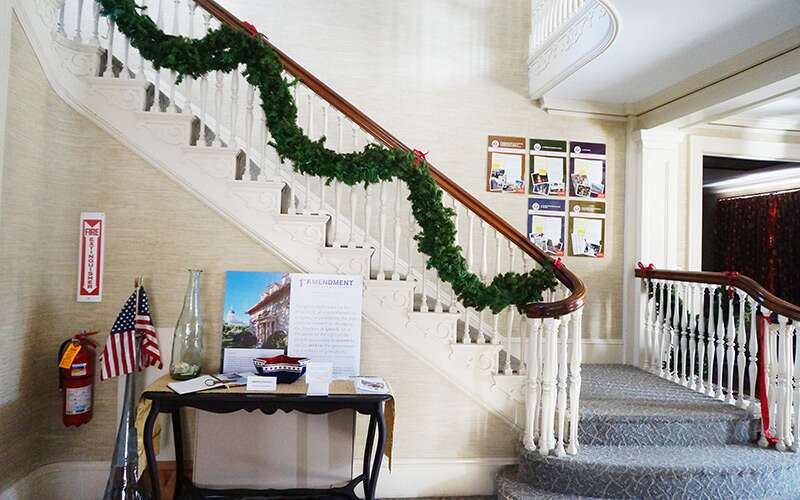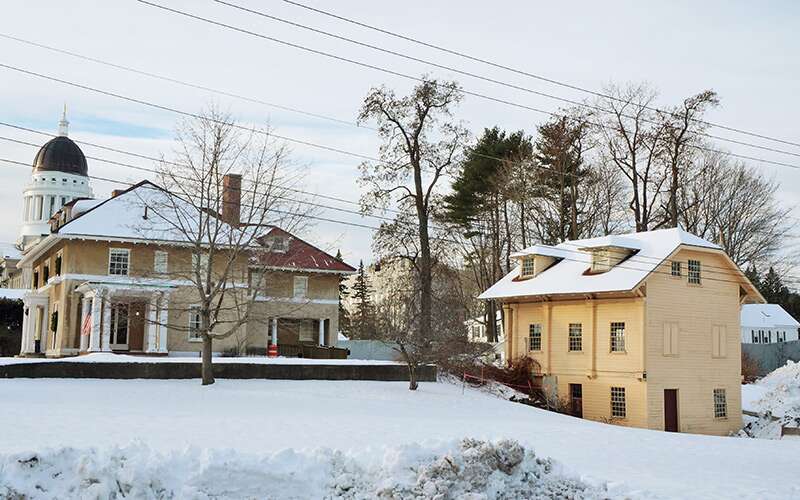
First Amendment Museum will more than double its size with addition
 Photo / Maureen Milliken
The First Amendment Museum, at 184 State St., Augusta, will more than double its size with a recently approved addition.
Photo / Maureen Milliken
The First Amendment Museum, at 184 State St., Augusta, will more than double its size with a recently approved addition.
AUGUSTA — A new sign went up in front of the First Amendment Museum at 184 State St. Tuesday; the old one, which said “under construction,” is outdated.
Not that there isn’t a lot more construction slated for the former Gannett House. The 11,000-square-foot house, which is next door to the governor’s residence, the Blaine House, has been evolving into the museum since the Gannett family donated it in 2015.
Last month, the city’s planning board approved adding 17,017 square feet that will allow accessible use of the 107-year-old house on all three floors, as well as providing an entrance that’s near parking, reception and visitor services.
The plan is also to turn the house’s 1911 two-floor garage into a meeting place, as well as put some of the museum’s mechanical functions on the lower floor, which will be near much of the parking on the sloping property.
While a lot remains to be done — the addition construction is slated to begin in 2020 — the museum project is moving along since the house was donated by the Gannett family in 2015.
“We’ve really made a lot of progress,” said Executive Director Rebecca Lazure Tuesday as she and assistant Kelley Doore prepared for a “birthday bash” later that day to celebrate the 227th anniversary of the Bill of Rights. “Things are happening here.”
An ever-evolving project

The project involving the house began almost a decade ago.
The house, which was built by Maine magazine publisher William Gannett in 1911 as a wedding gift for his son, Guy Gannett, is on the National Register of Historic places. Guy Gannett moved to Portland a decade later, after he bought the Portland Press Herald, as well as the Evening Express, Maine Sunday Telegram, Kennebec Journal and Waterville Sentinel. The company, which was not related to national newspaper chain Virginia-based Gannett Co., sold the papers in 1993.
The house had been owned by the state since 1973, and was used for state offices until 2010.
When the museum project was proposed by the Gannett family, the state initially wanted to retain ownership of the then-vacant building and lease it for the project. A bill in 2013 sponsored by Sen. Roger Katz, R-Augusta, allowed the Gannett family to buy the building back at market value and donate it for the museum.
The sale of the building was finalized in 2015.
Lazure said the restrictions of the legislation that allowed the sale are strict and specific — its use must be the museum.
At the time the project first was proposed, Genie Gannett, Guy Gannett’s granddaughter and a Readfield resident, said it was inspired both by her mother’s desire that the house be restored and a recent visit Gannett had taken to the Newseum in Washington, D.C.
“We thought we could tell the story of our family and the publishing business, but then thought nobody would care about that but us,” Gannett told the Kennebec Journal in 2014. “Then we got talking about the First Amendment and a museum as more of an interactive center where kids and adults could have an experience with the First Amendment and its role as the guardian of democracy.”
Careful renovations

Lazure said that the project isn’t taking advantage of historic preservation tax credits, because there is no bank financing or other elements that would make the credits necessary.
The sale requirements are also that the construction project has specific oversight from the Maine Historic Preservation Commission and the Capitol Planning Commission.
The building has a new roof and windows, and much of what made it into office space in recent years has been removed.
There is more to be done — for instance in the sun room, where the dome of the State House can be seen beyond the hedges of the Blaine house, a portion of removed laminate floor shows original slate tiles six inches below.
Lazure said the unique historic features of the house, including much of the stucco and Mediterranean Revival design elements that were lost over the years, will be restored under the design by 2A Architects of Rockport.
The newer elements, including the addition, are designed to complement the historic home and maintain the residential feel of the property,” she said.
Guidelines from the Secretary of the Interior's Standards for Historic Preservation are that additions and new elements complement, rather than mimic the appearance of historic structures.
“The museum is using the spaces that are unique to a home to tell the story of the First Amendment through the spaces that we all use every day — our kitchens, living rooms, libraries and family rooms.”
The new addition, besides accessibility, reception, and other functions, will have an upstairs maker space, where visitors will be able to participate in hands-on creative explorations of First Amendment freedoms.
Moving forward

Programs at the museum are already underway, despite the fact the staff consists of Lazure and Doore.
The many purposes it will serve are still evolving, but Lazure said the hope is it will be a resource for research as well as a place for casual visitors.
The museum won’t be open to the public until after the addition is built, but it’s open now to nonprofit groups that would like to use the space, Lazure said.
A traveling exhibit is being finalized and an open house during Free Speech Week in October drew a crowd.
Over the summer, the museum held an interactive First Amendment camp for children at Augusta’s Vile’s Arboretum.
An oral history project that can be accessed by an audio kiosk tells stories of personal encounters with the First Amendment. Lazure said there are already 30 — a few highlighted by life-sized panels in the museum’s yet-to-be renovated sun room — but the museum would love to collect more.
Among those featured is Toni Richardson, who won a free-speech case in the Augusta school system.
Another is Kafir Abdullah, a native of Iraq, who tells of how he never encountered the kind of freedom of expression that he has since moving to America.
“For me because of my life history, I can taste — I can feel — the real value of these basic freedoms,” his display says.
There are also several journalists featured in the exhibit, Lazure said, and frequently the First Amendment is associated with journalism. But she said one of the major goals of the museum is to stress that the First Amendment is is something all residents of the U.S. live every day.
“We’d love some individual stories on how the First Amendment has related to people’s lives,” she said.










Comments